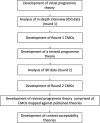Acceptability of family planning in a changing context in Uganda: a realist evaluation at two time points
- PMID: 35396286
- PMCID: PMC8995957
- DOI: 10.1136/bmjopen-2021-054277
Acceptability of family planning in a changing context in Uganda: a realist evaluation at two time points
Abstract
Objectives: This study sought to understand, during an intervention which integrated family planning (FP) and immunisation, (1) if and how prevailing contextual factors influenced acceptability and use of modern contraceptive methods (MCMs) in a pastoral community in Uganda, (2) what mechanisms were triggered by these contextual factors (3) if these contextual factors changed between two time points 2 years apart and (4) the impact of contextual changes on mechanisms triggered and acceptability and use outcomes.
Design: Qualitative realist evaluation over two time points.
Setting: Government health facilities in Moroto District, Karamoja, Uganda.
Participants: 69 participants involved in the delivery and uptake of integrated FP and childhood immunisation services.
Intervention: Integrated delivery of FP and childhood immunisation services offered to women accessing immunisation services in health facilities between January 2016 and December 2019.
Results: Four key themes were identified that encompassed context and mechanisms influencing acceptability of MCMs across both time points of the evaluation. These were: (1) fear of side effects of MCMs; (2) preference for natural FP methods; (3) pastoral lifestyles in the community and (4) food insecurity. The context of these themes changed over time leading to the triggering of mechanisms with an overall increase in acceptability of MCMs over time. Key mechanisms of acceptability triggered included: affective attitude, intervention coherence, self-efficacy, perceived effectiveness and opportunity cost, leading to the development of three context-acceptability theories.
Conclusions: In this study, social and cultural norms played a strong role in influencing acceptability of the intervention. The context combined with intervention components were found to trigger several mechanisms that mapped to constructs of diffusion of innovations and acted as catalysts for mechanisms of acceptability. The context in which the intervention was implemented changed leading to the triggering of mechanisms and an increase in the perceived value and acceptability of MCM use.
Keywords: Organisation of health services; QUALITATIVE RESEARCH; Reproductive medicine.
© Author(s) (or their employer(s)) 2022. Re-use permitted under CC BY-NC. No commercial re-use. See rights and permissions. Published by BMJ.
Conflict of interest statement
Competing interests: None declared.
Figures



References
-
- Zhu B-P, et al. . Effect of the interval between pregnancies on perinatal outcomes 1999;340:589–94. - PubMed
-
- Organization, W.H . Sustainable development goals 2015.
-
- Stephenson R, Hennink M. Barriers to family planning service use among the urban poor in Pakistan. Asia Pac Popul J 2005;19:5–26. 10.18356/e54a6ab6-en - DOI
Publication types
MeSH terms
LinkOut - more resources
Full Text Sources
Medical
